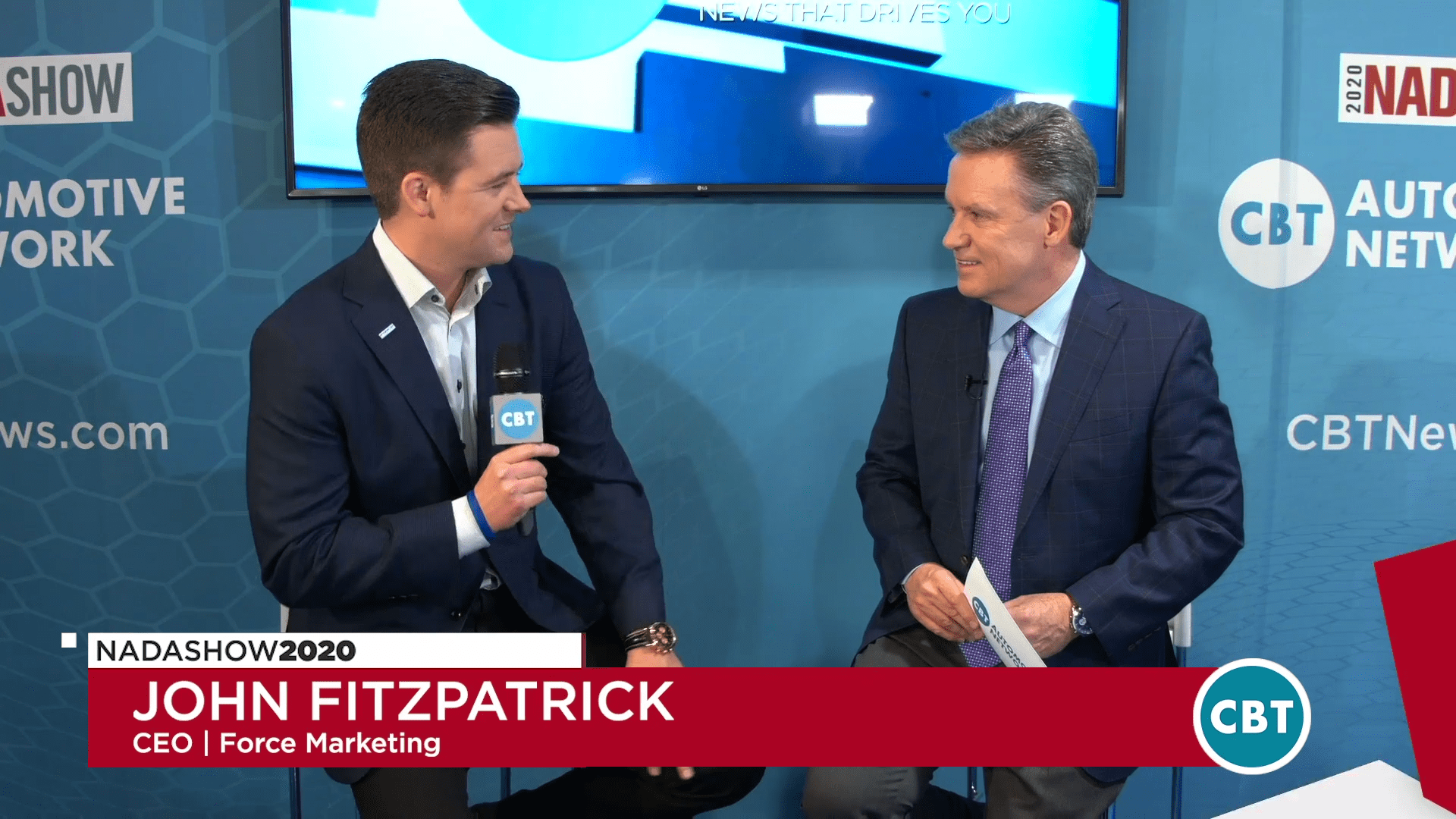Force Marketing‘s John Fitzpatrick joined Jim on the CBT Stage at NADA 2020 to explain how using video in an omni-channel marketing approach can help improve customers’ shopping and car buying experience.


VIDEO TRANSCRIPT:
Speaker 1: CBT news on location in Las Vegas for the 2020 NADA Show.
Jim Fitzpatrick: John, for some of the people that haven’t made it out to the NADA Convention that are watching us right now, what are some of the things, what are some of the buzz words that you hear going on? What do dealers want to see?
John Fitzpatrick: They built their businesses for years on sight, sound and motion, and they’re understanding now that the way consumers are interacting with their brand is different. It’s changed in the way of the device that they find them on, and the way in which they go through their path to purchase.
Jim Fitzpatrick: That’s for sure.
John Fitzpatrick: We are bringing back to light that sight, sound and motion works, but you’ve got to get it through the right channel. It’s got to be omnichannel. What we mean by omni-channel is delivering the same experience across multiple channels to different audience segments of your local market.
Jim Fitzpatrick: When you say sight, sound and motion, you’re talking about video.
John Fitzpatrick: Talking about video.
Jim Fitzpatrick: Talking about video.
John Fitzpatrick: There we go. Forever, it’s been linear TV and linear radio that they’ve been able to push that message out. We’ve developed a product called DRIVE, which is automated dynamic video. Our special angle is, we’ve built the channels to YouTube, to Facebook and to CTV and OTT and other programmatic networks so that when you’ve identified an in market shopper, you can then deploy video directly to those consumers in an omnichannel way.
Jim Fitzpatrick: Unlike TV, where it’s a spray and pray, I’m going to buy the 10 o’clock news and hope that there’s a car buyer out there watching the 10 o’clock news to buy my Chevy that we’re selling at our dealership, this is much more specific. Talk about that.
John Fitzpatrick: Much more specific. We’ve found the best data partners in the area, and we’ve really leaned into our original approach was focusing on the dealers first party data, connectivity of DMS. Thanks to Helix technologies, a company that we started, which is SaaS based business all around, taking the data that’s within a DMS and a CRM and making that data actionable, and reporting on that so that they can drive the cost of their advertising expense down by cutting out the waste and getting more direct.
Jim Fitzpatrick: Which is what every dealer wants.
John Fitzpatrick: That’s right. That system has allowed us to develop products like DRIVE where we can now deliver against that audience. It’s really important.
Jim Fitzpatrick: In your estimation, if a dealer says to you, “John, I’m a Chevy dealer outside of a metro. What should I be spending on advertising per car?”
John Fitzpatrick: We want to dive in to their market. Every market does have differences. There’s no doubt about it. Want to look at their inventory. We want to look at how much they’ve been spending cost per unit, and then, we want to really give them a good understanding of what it should be in that area. But just to give you roundabout numbers, NADA has shared forever that the average cost per unit sold is about $608. Now, we really dove into that study. What that study does though, however, is it analyzes the total spend only against new car output.
Jim Fitzpatrick: Really?
John Fitzpatrick: The used cars are not taken into consideration on that. When you go into the numbers, the real number is about $356 cost per unit, new and used on total ads spend.
Jim Fitzpatrick: I didn’t know that, interesting.
John Fitzpatrick: It’s really 356. You take the 356 and you look at our average CPU, which is very important to us because everything we talk about with our dealers is about the outcome. How we increase in market share on new? What is their CPO strategy and how are we increasing that? Retention rate in service. We want to talk to the dealers about what matters most to them, which is the outcomes they’re looking for. When you think about the way we’re interacting with dealers, it’s quite different than what they’re used to. Back to that 356 per car, that the NADA average, our average CPU on about 900 [inaudible] now that we’re working with nationwide-
Jim Fitzpatrick: Wow, 900!
John Fitzpatrick: Yup. Team’s done a phenomenal job of growing the business.
Jim Fitzpatrick: From your perspective, you have a very unique position because you’re knowing what’s working and what’s not working and what those numbers should be for dealers.
John Fitzpatrick: That’s right, and then pulling those levers all day because I don’t care how good your technology is, you’ve got to have good lever pullers. As our great client, Rachel Richards tells us at Sonic, got to have those good lever pullers that can communicate what you’re doing well.
Jim Fitzpatrick: That’s right.
John Fitzpatrick: And make sure that everyone’s using the technology properly. But back to your 356, that really is what NADA should be representing because new and used is all part of it. I don’t think there’s anybody that’s just spending dollars against new.
Jim Fitzpatrick: No, absolutely not.
John Fitzpatrick: Used is important.
Jim Fitzpatrick: Yup.
John Fitzpatrick: Our 900 clients are seeing an average of under $200 cost per unit.
Jim Fitzpatrick: Wow.
John Fitzpatric…: If you think about that-
Jim Fitzpatrick: That’s incredible.
John Fitzpatrick: And put that into the metrics of your business-
Jim Fitzpatrick: That difference, that other $150 goes right to the bottom line.
John Fitzpatrick: It should.
Jim Fitzpatrick: Yeah, it should. That’s exactly right.
John Fitzpatrick: Forever, we’ve talked about the three legged stool of a dealer and their costs and how they’re important to the business, inventory, people and advertising.
Jim Fitzpatrick: That’s right.
John Fitzpatrick: We think we can help advertising, and here’s another thing. We think we can help an inventory because if we’re turning the vehicles faster, that’s going to save the dealer money.
Jim Fitzpatrick: There’s no question.
John Fitzpatrick: If we are bringing in the right trade-ins because we’re very pinpoint in who we’re targeting.
Jim Fitzpatrick: That’s a good point.
John Fitzpatrick: Now they’re spending less money to go find the vehicles, and so we think, not only are we helping drive down the cost of advertising, we’re helping with the inventory component.
Jim Fitzpatrick: You might also be helping with the people aspect because if you’re driving more leads to that dealership, that are more qualified ups, guess where the sales people want to work.
John Fitzpatrick: There you go. I like that. We’re helping in all three.
Jim Fitzpatrick: That’s exactly right.
John Fitzpatrick: You’re absolutely right. A dealership operation that is running and gunning has less turnover, there’s no doubt, than one that’s poorly managed.
Jim Fitzpatrick: Absolutely.
John Fitzpatrick: I guess we are in a way.
Jim Fitzpatrick: We have you on CBT all the time, and you mentioned the last time that you actually handle four of the top seven publicly traded companies. That’s pretty cool for one marketing company to be in with four out of the top seven. Are you shooting for the other three?
John Fitzpatrick: Yeah. Look, why not? Here’s the thing about that. The big names are all great to say, hey, we work with this group and we work with that group, but here’s behind that what’s special is those organizations make us better. They tell us what techniques to do. They tell us the feedback from the showroom that we don’t get. The data will only tell you so much. The GM dealer partners at Berkshire Hathaway, the corporate team at Sonic, Lithia, we’re really growing the Lithia relationship. And by the way, all of the other clients that we have across the country that have 10 stores or five stores or whatever it might be, I love when they challenge us because it makes us better.
Jim Fitzpatrick: Of course.
John Fitzpatrick: It absolutely makes us better, makes our partnership better.
Jim Fitzpatrick: Of course.
John Fitzpatrick: We just can’t say enough good things about-
Jim Fitzpatrick: What do you say to the dealer that walks up to you here at the show today and says, “John, if you had to focus on one or two things in 2020 with regard to the marketing at my dealership, what should I be focused on?”
John Fitzpatrick: I think it goes back to the big push we have with our DRIVE product. We created the DRIVE product because when we took a look at the supply and demand curve against consumers and the way they were shopping, they are consuming video at an alarming rate across all of these channels. Oracle told us, IHS backed it, about 97% of consumers are utilizing video to make their buying decision across that 90 day or 45 day path to purchase, but only 3% to 4% of dealers have an active video strategy against that 97% audience.
Jim Fitzpatrick: Oh my God, that’s crazy.
John Fitzpatrick: The supply demand is way off. Those dollars that you could invest, and we look at marketing as an investment, is absolutely geared towards taking advantage of that in 2020 and 2021. Now, everybody floods it, it’s going to change the curve and it’ll be costly, but for right now, we can’t preach it enough. The consumers are driving the behavior that video dynamically that gives you scale, that will allow you to have essentially a video for every inventory, on your lot, every piece of inventory on your lot.
Jim Fitzpatrick: Very cool.
John Fitzpatrick: That’s an important piece and you need to be focused on that.
Jim Fitzpatrick: And your company does that.
John Fitzpatrick: That’s what we do. The other thing we’re doing is we understand that we’ve invested a lot of money behind this over the last five years. We’ve also looked at the other agency competitive landscape that maybe hasn’t made that investment. We want them to partner with us, utilize the technology. We’ve got partnership arrangements. Right now, we have over 15 agencies reselling the DRIVE product, and it’s making their relationships better. Keep your relationships where they are.
John Fitzpatrick: If you’re working with Force Marketing, we’ve also been a leader in paid search, Facebook advertising, display and retargeting. Mail and email has been a component, foundation of our business. When you really think about an omnichannel approach against these audiences, we think we’ve got a really good opportunity to partner in a dynamic way with dealers that they might not currently be getting.
Jim Fitzpatrick: We spoke to one of your clients that was here at the NADA Convention, just before we went on here, to get a feel for how you’re servicing them, and they said they were actually able to do away with three other marketing vendors.
John Fitzpatrick: Is that right?
Jim Fitzpatrick: Because you guys handled it all. Have you found that to be the case with the other clients?
John Fitzpatrick: Yeah. The average dealers, working with 14 on average, some or more marketing partners.
Jim Fitzpatrick: Oh my God.
John Fitzpatrick: That’s 14 different conversations in a 30 day span.
Jim Fitzpatrick: [crosstalk 00:09:41].
John Fitzpatrick: 14 different strategies.
Jim Fitzpatrick: That’s crazy.
John Fitzpatrick: How could you possibly be effective with your ad dollars with 14 different strategies?
Jim Fitzpatrick: Yeah, that’s nuts.
John Fitzpatrick: We’ve got to do a better job in this industry from a vendor to dealer relationship of working together on the vendor side so that they can sell cars. We need to help them do that at a more cost effective way. Ultimately, we believe at Force, if we can make the dealer to customer shopping experience better, the shopping experience will make the buying experience better, and we’ll have great relationships for a long time.
Jim Fitzpatrick: Which then leads to a happier customer with better reviews. It leads to a happier sales person, which also reduces the turnover in the sales department, as well, and it’s also going to bring that customer back for service. If a customer customer’s not happy in the showroom, they’re not coming back to the service center.
John Fitzpatrick: Yeah. Amen.
Jim Fitzpatrick: No question about it. John Fitzpatrick, president, CEO of Force Marketing, for dealers that are listening to us have this discussion, guess what? Video is alive and well and it’s back in a big way, so long as you do it right. John at Force Marketing has got the answer for that and the solution. Check out Force Marketing at force marketing.com, right?
John Fitzpatrick: That’s right.
Jim Fitzpatrick: Fantastic. If you want to call John direct, I’m sure that you’d be happy to give that dealer an analysis.
John Fitzpatrick: Of course.
Jim Fitzpatrick: Of what they’re currently doing and how you can help them, no obligation, right?
John Fitzpatrick: Absolutely. We’ve got a great team, whether it’s me or anybody on the team, they do a phenomenal job of-
Jim Fitzpatrick: And 15 years of experience so nobody knows it better. John, thanks so much for joining us.
John Fitzpatrick: Thanks for having us.
Jim Fitzpatrick: Absolutely.
John Fitzpatrick: Thanks for what you’re doing with the industry.
Jim Fitzpatrick: Thanks for partnering with us here at the NADA Convention. It’s always great.
John Fitzpatrick: Absolutely.
Jim Fitzpatrick: Thanks.
John Fitzpatrick: Thank you.








